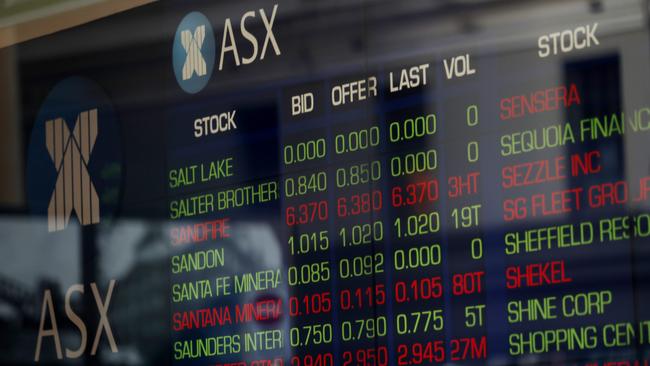Markets in a spin after surge in US inflation rate
Markets had their first taste of what to expect as inflation started to take hold across the global economy, but local shares remained resilient.

Markets had their first taste of what to expect as inflation started to take hold across the global economy, but local shares remained resilient helped by cashed-up investors.
The Australian sharemarket initially saw a sharp drop amid a reassessment of valuations in the most expensive shares as bond yields spiked on the highest US inflation figures in more than three decades. But a jump in iron ore prices came to the rescue.
The S&P/ASX 200 fell 0.6 per cent at a seven-day low close of 7381.95, but bounced off an intraday low of 7329.5 where it was down as much as 1.2 per cent.
High valuation technology and healthcare shares and so-called “bond proxies” in the real estate sector dragged on the local bourse as the 10-year bond yield jumped as much as 13 basis points to 1.86 per cent before a brief dip to 1.79 per cent market on disappointing local employment data.
The Australian dollar also pulled back to a four-week low of US72.95c.
But economists said a 46,300 fall in employment in Australia and a 5.2 per cent unemployment rate for October were exaggerated by the fact that the employment survey was conducted earlier than usual, in late September and early October, when NSW and Victoria would still be caught up in lockdowns.
Interestingly, the ASX 200 bounced from 7374 to 7406 immediately after the jobs data.
While the jobs data were quickly dismissed as “old news” that failed to capture the start of what is expected to be a strong post-lockdown rebound in the Australian economy, the reflexive action from investors remained to buy on bad news because it might delay the start of rate hikes.
“With mobility continuing to improve over recent weeks, we are confident that the next monthly labour force report will reveal a sharp jump in employment,” said Nomura economist Andrew Ticehurst.
Helping to support the local market were big gains in the mining sector.
Fortescue Metals rose 8.2 per cent, BHP rose 2.6 per cent and Rio Tinto gained 2.1 per cent as Dalian iron ore futures surged 7 per cent to $US89.20 a tonne after the Wall Street Journal said the People’s Bank of China was considering easing rules to let struggling developers like China Evergrande Group sell assets to avoid defaults.
Northern Star rose 4.8 per cent, Evolution jumped 5.1 per cent and Newcrest Mining rose 2.4 per cent as the Australian dollar gold price surged to a 12-month high of $US2538.94 a tonne.
The local market is teeming with expensive stocks across industrial shares, where some companies that lack pricing power may be vulnerable to a rise in bond yields.
But the local bourse also has some excellent inflation hedges in commodities producers – particularly gold and energy. Financials may benefit from higher net interest margins if bond yields rise, although at some point higher interest rates could hurt banks via the property market.
On Wall Street the benchmark the S&P 500 fell 0.8 per cent to 4646.71 points but was still its third highest close in history, the US 10-year Treasury yield rose 11 basis points to a five-day high of 1.55 per cent, gold rose 1 per cent to $US1849.60 an ounce and Bitcoin hit a record high of $US68,991.84.
In its global and Australian outlook, UBS saw global economic growth booming 7 per cent by year end, before stepping down to a still strong 4.7 per cent in 2022 and 3.6 per cent in 2023.
Global headline inflation was expected to stay high in 2022 at 3.9 per cent, then slow to a below consensus 2.7 per cent in 2023, assuming supply bottlenecks ease from the March quarter of 2022.
For the US, UBS was more bullish on growth and inflation than the market, seeing GDP at 4.2 per cent on year for 2022 and 3 per cent for 2023, and headline CPI of 4.2 per cent 2022 – via a further spike in coming months to a potentially worrisome level of about 7 per cent on year.
“Importantly, UBS is then well below consensus for US inflation in 2023 at 1.4 per cent,” said UBS Australia chief economist George Tharenou.
“This feeds into the dovish view on the Fed, still with no rate hikes in 2022, and only one hike to 0.5 per cent by end-2023.”
Elsewhere, to the end of 2023, UBS still sees no rate hikes from the Bank of Japan or European Central Bank, albeit is relatively hawkish on the Bank of Canada and Bank of England.
It also saw Chinese economic growth next year similar to consensus at 5.4 per cent, before a slowing to 2023 to around “trend” growth of 5 per cent. That will be key for the global economy.
“Elsewhere, for equities, S&P 500 earnings are seen coming in 9-10 per cent above consensus for the second quarter of 2021, lifting the price index to a peak of 5000,” Mr Tharenou said.
“However, subsequent earnings downgrades, combined with higher real interest rates, should cause a valuation derating towards 4,850 by the end of 2022.”






To join the conversation, please log in. Don't have an account? Register
Join the conversation, you are commenting as Logout